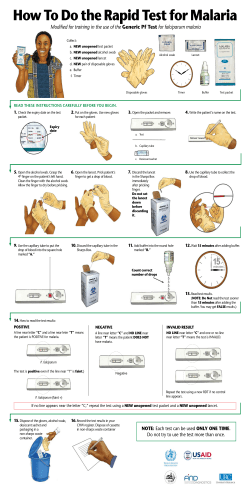
Background Results Methods Conclusions
Disease burden from P. vivax and P. knowlesi malaria in children in Sabah, Malaysia Grigg MJ1, William T1,2,3, Menon J2, Barber BE1, Wilkes CS1, Price RN1, Yeo TW1, Anstey NM1 1. Infectious Disease Society Sabah, Malaysia - Menzies School of Health Research, Australia 3. Jesselton Medical Centre, Kota Kinabalu, Sabah, Malaysia 2. CRC & Ministry of Health, Sabah, Malaysia Background P. vivax malaria in Malaysia Results • Significant reductions in Plasmodium vivax malaria cases have occurred in Malaysia due to effective ongoing national malaria eradication efforts • In other areas the prevalence of P. vivax has risen as P. falciparum decreases, while contrastingly in Eastern Malaysia, zoonotic P. knowlesi malaria has instead increased • In Eastern Malaysia, P. vivax, unlike P. knowlesi, continues to predominantly infect children • Rates of P. vivax recurrence or relapse and associated morbidity remain poorly defined in Malaysia, particularly given increasing resistance to chloroquine currently used as the first line blood stage treatment • No previous prospective studies of P. knowlesi in children have been reported Fig. 2: Baseline symptoms Fig. 1: Enrolment flowchart of PCR confirmed malaria cases Malaria admissions 602 Children (age<12) 107 P. vivax 65 P. knowlesi 25 P. vivax (n=65) Study sites P. knowlesi (n=25) P. falciparum (n=12) P-value Age 8 8 9 median (IQR)[range] (5-10)[0.7-12] (5-10)[0.1-12] (7.5-10.5)[3-12] Gender 54 64 50 0.514 Weight 21 23 21 median kg (IQR) (15-25)[9-52] (17-29)[3-37] (19-29)[10-56] 0.294 Parasite count/μL 4739 1034 9596 geometric mean (CI95) (3290-6828) (504-2120) (2706-34028) <0.001 (vs. Pk) 0.322 (vs. Pf) 16 (25) 1 (4) 1 (8) 0.015 10.1 10.3 10.9 (9.4-11.3) [5.8-13.1] (9.4-11.1) [7.1-12.6] (8.8-11.6) [6.8-13.9] 12 (19) 24 (50) 3 (13) 12 (57) 3 (30) 3 (43) 0.816 0.764 46 (72) 4 (6) 17 (71) 0 6 (50) 1 (8) 0.859 0.587 % male Gametocytaemia positive at baseline n (%) Anaemia (WHO criteria) Baseline n (%) Day 28 post treatment Thrombocytopenia n (%) • Patients 12 years or younger with confirmed malaria were enrolled as part of prospective malaria studies over a 2-year period from October 2013 to March 2015. P. falciparum/ P. vivax 1 Fig. 3: Clinical and laboratory features g/dL Baseline median (IQR)[range] Study participants P. malariae 4 P. falciparum 12 Haemoglobin Methods Adults 495 Platelets <150x103/uL Platelets <50x103/uL Acute kidney injury n (%) 0.451 0.649 (vs. Pk) 0.762 (vs. Pf) 8 (13) 1 (4) 1 (8) 0.277 (vs. Pk) 0.558 (vs. Pf) G6PD deficiency n (%) 3 (5) 1 (4) 1 (8) 0.951 Severe malaria 0 0 0 (AKIN criteria or creat>132/ul) n (%) • Patients admitted to hospital were enrolled at 3 district hospital sites in Sabah, Malaysia Chloroquine Artesunatemefloquine P. vivax recurrence 19 (51) 0 P. vivax relapse 0 0 Target dose (mg/kg) 25 12 / 25 Actual dose (mg/kg) 22 9 / 23 median (IQR) (20-26) (8-12) / (20-28) Before day 28 Fig. 4: Survival curve CQ vs. ACT Fig. 5: Haematological recovery Acknowledgements • Kudat, Kota Marudu, Pitas and QEH clinical and laboratory research staff • Sabah Department of Health & Ministry of Health, Malaysia • MSHR research staff and NHMRC, Australia • Asia-Pacific Malaria Elimination Network (APMEN): project number 108-07 • Monkeybar ESEI (UK) MRC project Study procedures • Demographic, clinical and epidemiological data were obtained after informed consent • Clinical, parasitological and biochemical features in children were compared at baseline and during 28 day follow-up where possible • Therapeutic efficacy of chloroquine (CQ) versus artemesinin-combination therapy (ACT) was assessed as part of a larger RCT • Ethics approval was given by the Malaysian Medical Research Ethics Committee (MREC) and Menzies School of Health Research, Australia (HREC) Conclusions • Anaemia is common in malaria due to each species, particularly post treatment • No P. vivax relapses were documented in passive follow up within the 2 year study period • Unlike in adults, thromboctyopenia was not present in all children with P. knowlesi malaria • No severe malaria was noted in children with any Plasmodium species (in contrast to that documented in adults) • There was no difference in the prevalence of anaemia, thrombocytopenia or acute kidney injury between malaria species • Parasite counts were higher in children with P. vivax compared to P. knowlesi malaria • 19/37 (51%) of children with P. vivax malaria treated with chloroquine had recurrent parasitaemia within 28 days • Those with recurrent P. vivax parasitaemia had a higher prevalence of anaemia at day 28
© Copyright 2025










